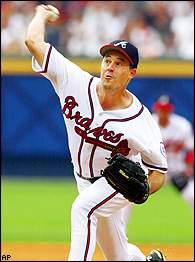Monday, January 09, 2006
What is Important in the Arm?


The Catapult: Getting the Shoulder to the Correct Position
I have read a lot recently about the mechanics on Mark Prior, the great young pitcher for the Chicago Cubs. I have even seen some photos of his external rotation of the elbow. In the picture, Prior’s elbow position is unbelievable. As his body goes forward, the elbow and forearm bend at a remarkable angle. It is as if his forearm is being broken in half.
Upon looking at the picture, I decided to exam his delivery further looking to see if Prior makes a complete rotation with the humerus bone inside the shoulder socket. I am looking for that specific movement because I hypothesize that successful pitchers like Roger Clemens, Nolan Ryan, and Greg Maddox, who have pitched into their forties and not lost velocity, all made complete rotations with the upper arm.
What is the humerus bone and how does it help the shoulder? The humerus bone is located in the upper arm. The bone attaches in the shoulder socket and at the elbow. At the two connecting points, the humerus bone is attached to several very important ligaments. First, at the shoulder socket, the humerus bone connects to the rotator cuff. This ligament holds the shoulder in place and allows the arm to be lifted. At the other end, the humerus bone connects to the ulna collateral ligament in the elbow. This ligament holds the elbow and forearm together. Both of these ligaments are commonly injured by pitchers from little league all the way to professional baseball. By injuring these ligaments, pitchers must undergo surgery to repair the damaged areas.
Why is a complete rotation of the humerus necessary to maintain a healthy arm? Since the humerus bone is attached to the rotator cuff and ulna collateral ligament, the bone must be put in motion properly to keep stress on these ligaments to a minimum. Applying momentum out of the pitcher’s hand break is a central component of reducing stress to the pitching arm. For instance, Greg Maddox, pictured above, illustrates exactly what I am talking about with regards to the humerus bone. As you can see, Maddox's upper arm has made a complete rotation from his hand break. His hand starts low out of the glove, with his throwing elbow making a small movement toward first base. As his body travels forward, the arm separates and lags behind. Quickly, Maddox rotates the shoulder, like a swimmer performing the crawl stroke, and puts it in a catapult-like position. At this point, his shoulder is externally rotated but the elbow flexion resembles a shot-putter. The evidence of this rotation can be identified in his upper arm/forearm relationship and release. Maddox’s humerus bone is elevated, above his shoulder. Getting his arm into this position required Maddox to use the low hand break and swing the arm backwards. By swinging the arm on the break, Maddox reduced rotator cuff stress. Using this momentum, Maddox maintains good elbow flexion and allows the arm to extend on the release. Using proper elbow extension, Maddox does not stretch and violently snap the ulna collateral ligament in his throwing elbow. He extends the arm and allows his hand to pronate naturally.
Looking at Prior’s delivery, it is a different story. His upper arm/forearm relationship is closer to 90 degrees. At this arm angle, he can generate maximum external rotation of his elbow. The snapping affect of the forearm generates velocity in his release, but places a significant amount of stress on the arm. If you compare pictures, glance at the humerus bone position during Maddox’s delivery and then compare it to Mark Prior. Maddox gets the upper arm high and uses leverage and momentum reducing stress and tension on the rotator cuff and ulna collateral nerve. Also, by maximizing extension, it seems Maddox releases the ball closer to home plate than Prior, even though Prior is significantly taller. I have found photos of Prior practicing a lower hand break and his forearm position appears less stressful when he practices these mechanics.
In has been my experience with pitchers that many young players throw just like Mark Prior. As a coach, I find this habit very hard to help a player break. Pitchers who practice a whip-like throw usually delivery from the ¾ arm slot and have a tendency to throw across their body. Since their arm path has been established and repeated, it is very difficult to break him from the habit.
If you want to view many informative breakdowns of effective pitching deliveries, check out: www.chrisoleary.com
Mr. O’Leary was assembled a variety of pictures that illustrate not only effective, but ineffective pitching motions. If you check out his site, I guarantee you will be amazed at the information he provides to parents and coaches. It seems Mr. O’Leary is dedicated to helping pitchers stay healthy and maximize their ability.
